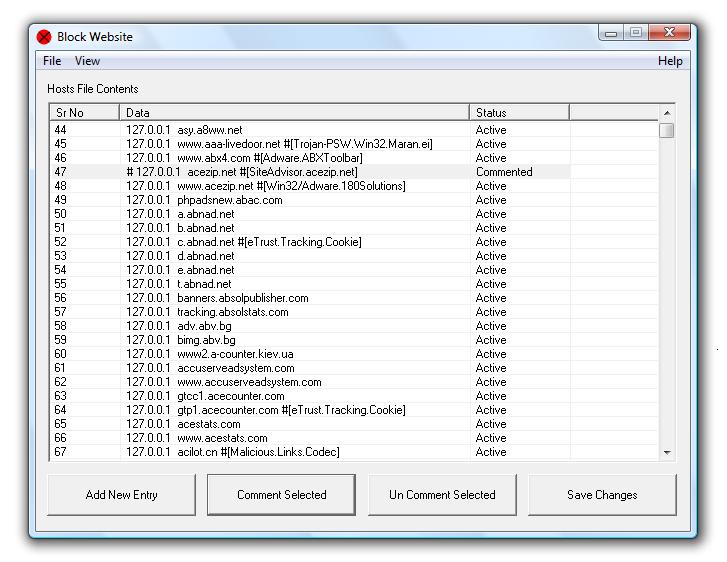Shows you how to block adobe activation by modifying your hosts file. It’s driving me nuts that I can’t block activation but I NEED my proxy! Second, if I had a serial to enter, I wouldn’t be needing to block. I would love your help on these two points.
- Block Website Utility`s Serial Killer
- Block Website Utility`s Serial Numbers
- Block Website Utility`s Serials
- Block Website Utility`s Serial Number
- Block Website Utility S Serial Number
This question already has an answer here:
- How do character device or character special files work? 5 answers
- Serial Port Utility is a professional communication software for serial port. Serialport Utility makes it more efficient for development of hardware-software application.
- Sysinternals File and Disk Utilities.; 2 minutes to read Contributors. In this article. AccessChk This tool shows you the accesses the user or group you specify has to files, Registry keys or Windows services. Graphical disk sector utility. Disk Usage (DU) View disk usage by directory.
How are character special files and block special files different from regular files in a Unix-like system? Why are they called “character special” and “block special” respectively?
jlliagremarked as duplicate by elbarna, Prvt_Yadv, muru, Stephen Harris, roaimaApr 14 at 19:35
This question has been asked before and already has an answer. If those answers do not fully address your question, please ask a new question.
3 Answers
When a program reads or writes data from a file, the requests go to a kernel driver. If the file is a regular file, the data is handled by a filesystem driver and it is typically stored in zones on a disk or other storage media, and the data that is read from a file is what was previously written in that place. There are other file types for which different things happen.
When data is read or written to a device file, the request is handled by the driver for that device. Each device file has an associated number which identifies the driver to use. What the device does with the data is its own business.
Block devices (also called block special files) usually behave a lot like ordinary files: they are an array of bytes, and the value that is read at a given location is the value that was last written there. Data from block device can be cached in memory and read back from cache; writes can be buffered. Block devices are normally seekable (i.e. there is a notion of position inside the file which the application can change). The name “block device” comes from the fact that the corresponding hardware typically reads and writes a whole block at a time (e.g. a sector on a hard disk).
Character devices (also called character special files) behave like pipes, serial ports, etc. Writing or reading to them is an immediate action. What the driver does with the data is its own business. Writing a byte to a character device might cause it to be displayed on screen, output on a serial port, converted into a sound, ... Reading a byte from a device might cause the serial port to wait for input, might return a random byte (/dev/urandom), ... The name “character device” comes from the fact that each character is handled individually.
See Wikipedia and Understanding /dev and its subdirs and files for more information.

 Gilles
GillesThey point to a driver and can be created by [mknod][1]. Looking at its man page, it seems that block devices are buffered while character devices are unbuffered. Block devices have a 'block size' that indicate the size of the blocks that are accessible. (for storage devices, the block size is typically between 512 B and 4 KiB) Storage devices and memory are typically accessed as block devices, while devices such as serial ports and terminals are typically accessed as character devices.
They are typically found in /dev (and can not function on partitions mounted with a nodev option (or its equivalent))
In ls -l show two comma-separated numbers for devices in the place where the size is normally found. Those are the major and minor numbers, that point to the driver. Their type are also indicated as 'c' or 'b' in the permission column of the ls -l output.
Block Website Utility`s Serial Killer
/dev can be populated in several ways. On recent Linux kernel versions udev is typically used, on Solaris it contains links to /devices, which is a virual devfs filesystem.
File Types in Unix/Linux: Ordinary or Regular Files, Directories, Device (Special) Files, Links, Named Pipes, and Sockets.
A device (special) file is an interface for a device driver that appears in a file system as if it were an ordinary file. They are Character devices, Block devices and Pseudo-devices (like /dev/null).
Character-driven will send one character at the time, thus you need a small load to carry, but have to make many requests. Block-driven means you get a large collection of characters (data) so you have a** bigger load but have to do less requests. Analogy: Basically the same as buying soda by the bottle, or by the crate.
Block-driven is useful when you know how much data you can expect, which is often the case with files on disk.
Character-driven is more practical when you don’t know when your data will stop thus you keep it running until no more characters get through. For example, an Internet connection, as you don’t know the size of the data stream that you will receive from the server.
For example:
- Character device drivers are special files allowing the OS to communicate with input/output devices. Examples: Keyboard, Mouse, Monitor, audio or graphics cards and Braille.
- Block devices are for communicating with storage devices and capable of buffering output and storing data for later retrieval. Examples: Hard drive, memory.